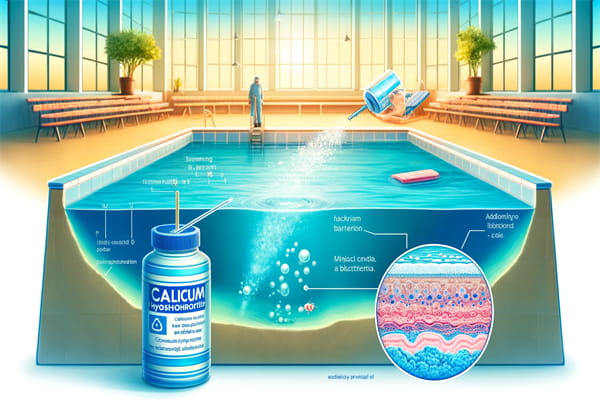If you've ever enjoyed a clear, clean swimming pool, you've likely experienced the benefits of calcium hypochlorite without even realizing it. This chemical is a powerhouse in keeping pools sanitary and safe for swimmers. Today, we're diving deep into the fascinating world of how calcium hypochlorite functions in swimming pools, unraveling its chemical processes and the indispensable role it plays in pool maintenance.

Ⅰ. How Calcium Hypochlorite Works
Calcium hypochlorite, commonly referred to as cal hypo, is a solid chemical used extensively in swimming pools to purify and disinfect the water. When introduced to water, calcium hypochlorite dissolves, releasing hypochlorous acid (HOCl) and hypochlorite ions (OCl-). These components are highly effective in killing harmful pathogens by destroying the cell walls of bacteria and other microbes, ensuring the pool is free from contaminants that can pose health risks.
Ⅱ. Roles of Calcium Hypochlorite in Swimming Pools
1.Disinfection
The primary role of calcium hypochlorite in swimming pools is to serve as a powerful disinfectant. When it dissolves in water, it releases hypochlorous acid (HOCl), a potent antimicrobial agent that rapidly destroys the cell structures of bacteria, viruses, algae, and fungi. This aggressive action ensures the pool remains a hostile environment for pathogens, thereby protecting swimmers from infections and preventing the pool from becoming a microorganism breeding ground.
2.Oxidation
Calcium hypochlorite excels not only as a disinfectant but also as a strong oxidizer. This property is crucial for breaking down organic matter such as sweat, body oils, and urine that swimmers introduce into the pool. Through oxidation, these organic compounds are decomposed into simpler, harmless substances, thereby preventing turbidity and eliminating foul odors. This process keeps the pool water pristine and inviting.
3.Algae Prevention
Algae can cause numerous problems in swimming pools, including creating slippery surfaces, clogging filtration systems, and producing an unsightly green discoloration. Calcium hypochlorite addresses these issues by maintaining a consistent chlorine residual, which effectively kills existing algae and inhibits future growth. This ongoing action helps to sustain the pool's visual appeal and structural functionality.
4.pH Levels
Although not primarily used for pH control, the application of calcium hypochlorite affects the pool's pH levels. Due to its basic nature, calcium hypochlorite tends to increase the water's pH, requiring regular adjustments to maintain balance. To ensure that the disinfectant operates effectively and that swimmers remain comfortable, pool operators must routinely monitor and adjust the pH levels, keeping them within the ideal range for effective sanitation.
5.Superchlorination/Shock Treatment
To address more acute problems such as algae blooms, cloudy water, or high levels of chloramines—known for causing the typical "chlorine smell" and irritating eyes and skin—pools occasionally need a shock treatment. Administering a high dose of calcium hypochlorite rapidly increases the chlorine concentration, quickly resolving these issues. This shock treatment effectively resets the pool's chemical balance, ensuring the water remains clear and safe for swimming.
Ⅲ. Conclusion
Calcium hypochlorite is more than just a pool chemical; it's an essential guardian of water quality and swimmer health. Consider adding a little more detail about why maintaining this balance is critical, perhaps linking to swimmer safety or pool longevity. For pool owners and maintenance crews, understanding how calcium hypochlorite works can lead to more effective pool management and a better swimming experience for everyone.











